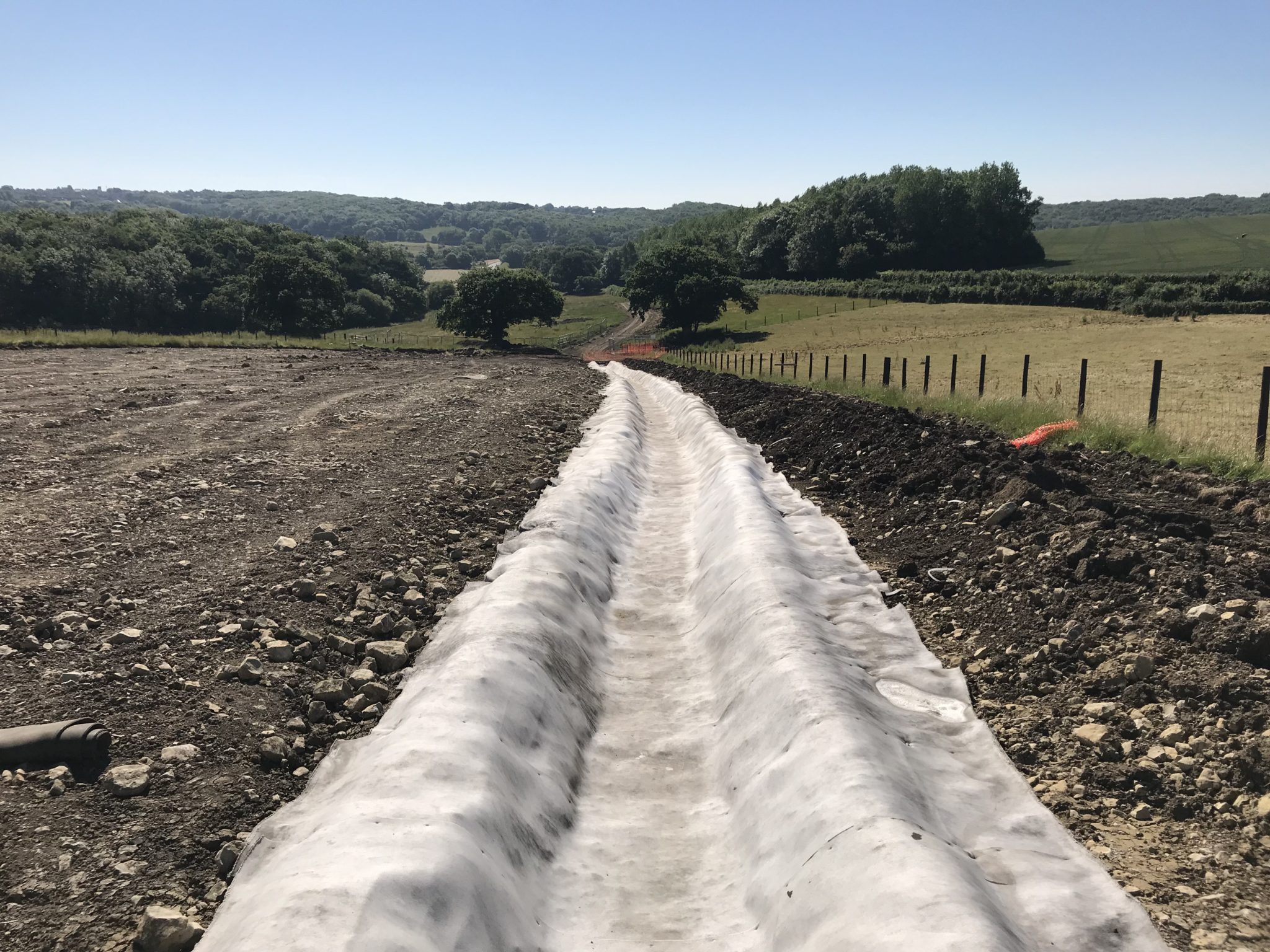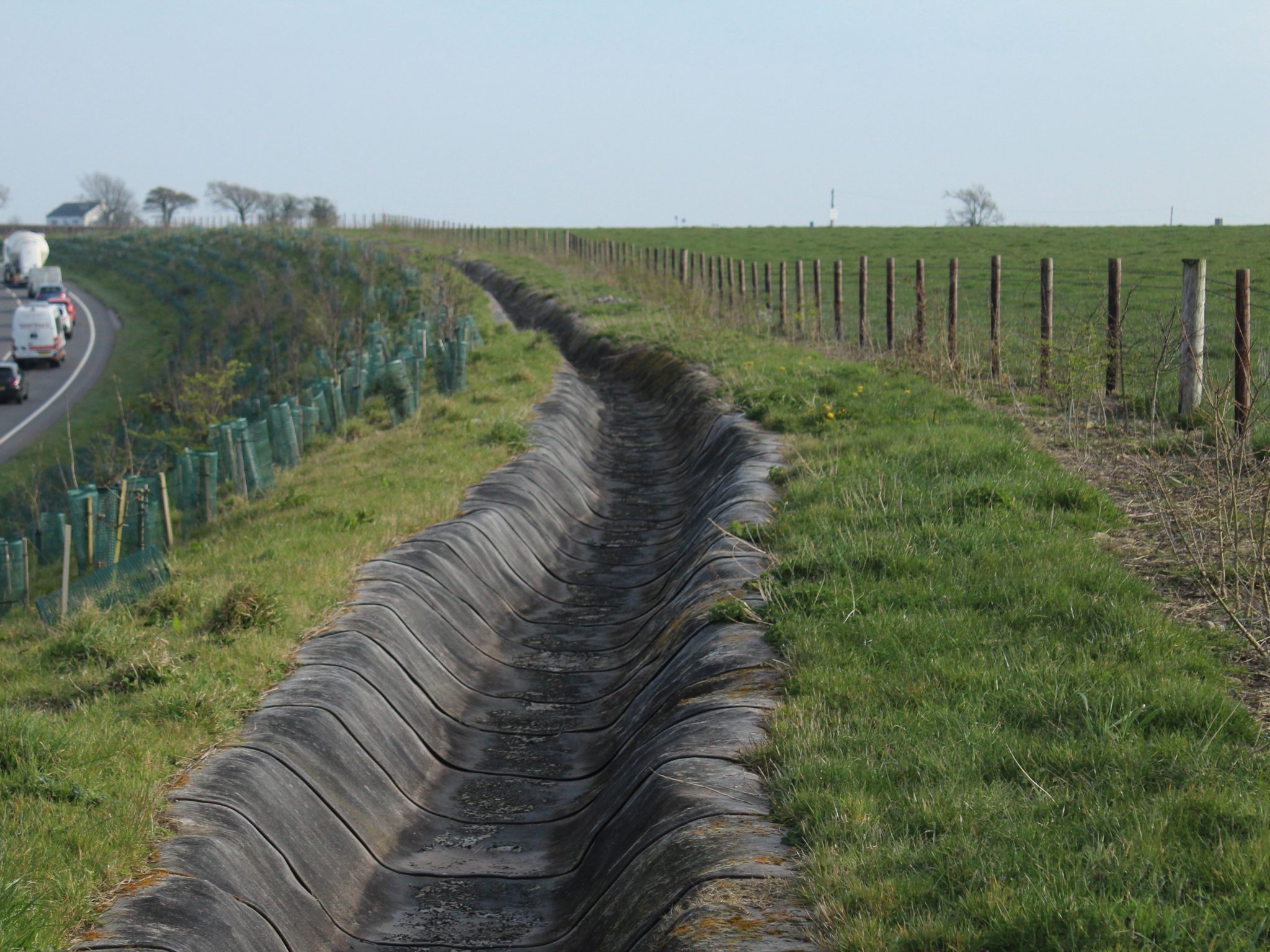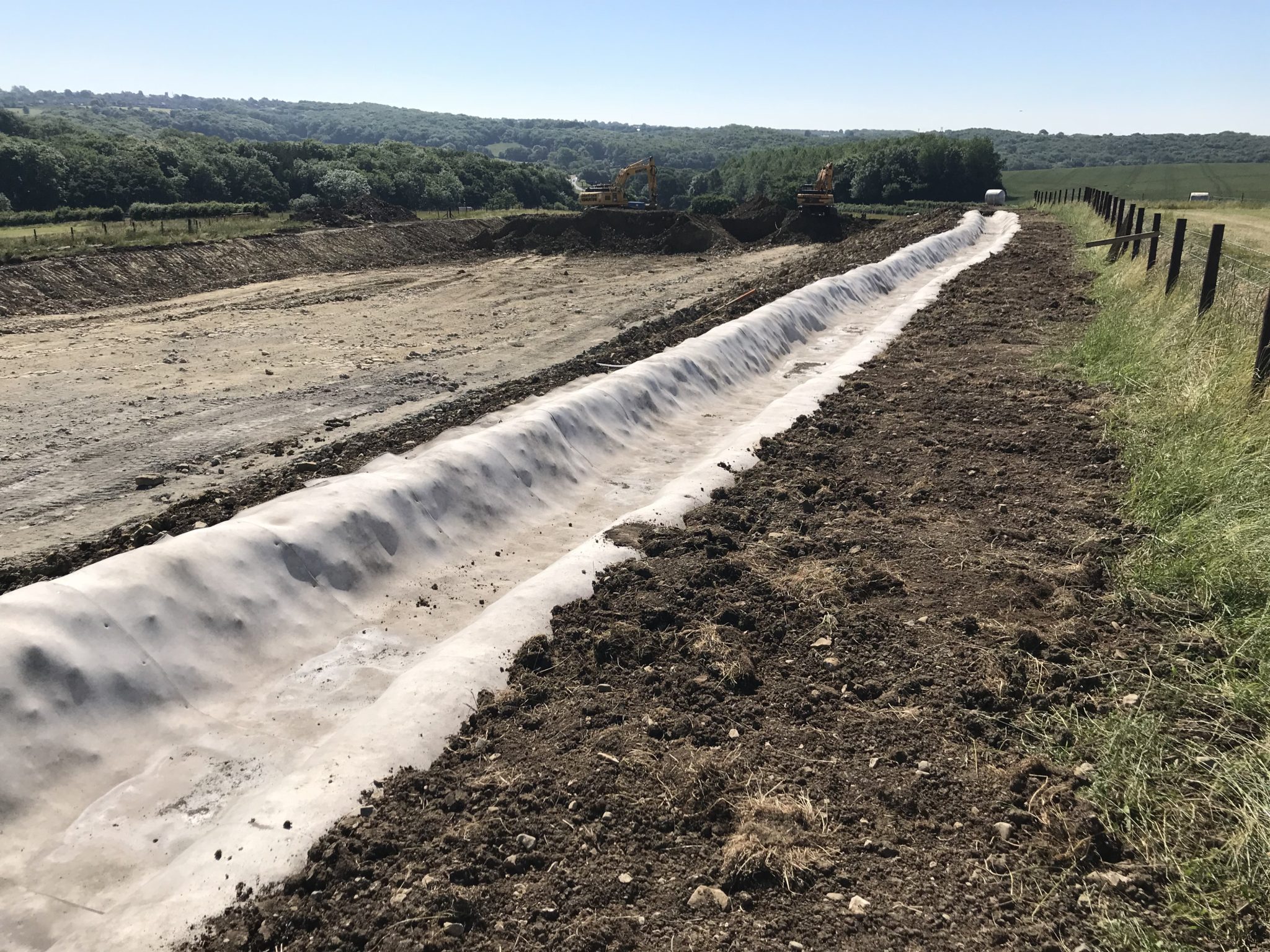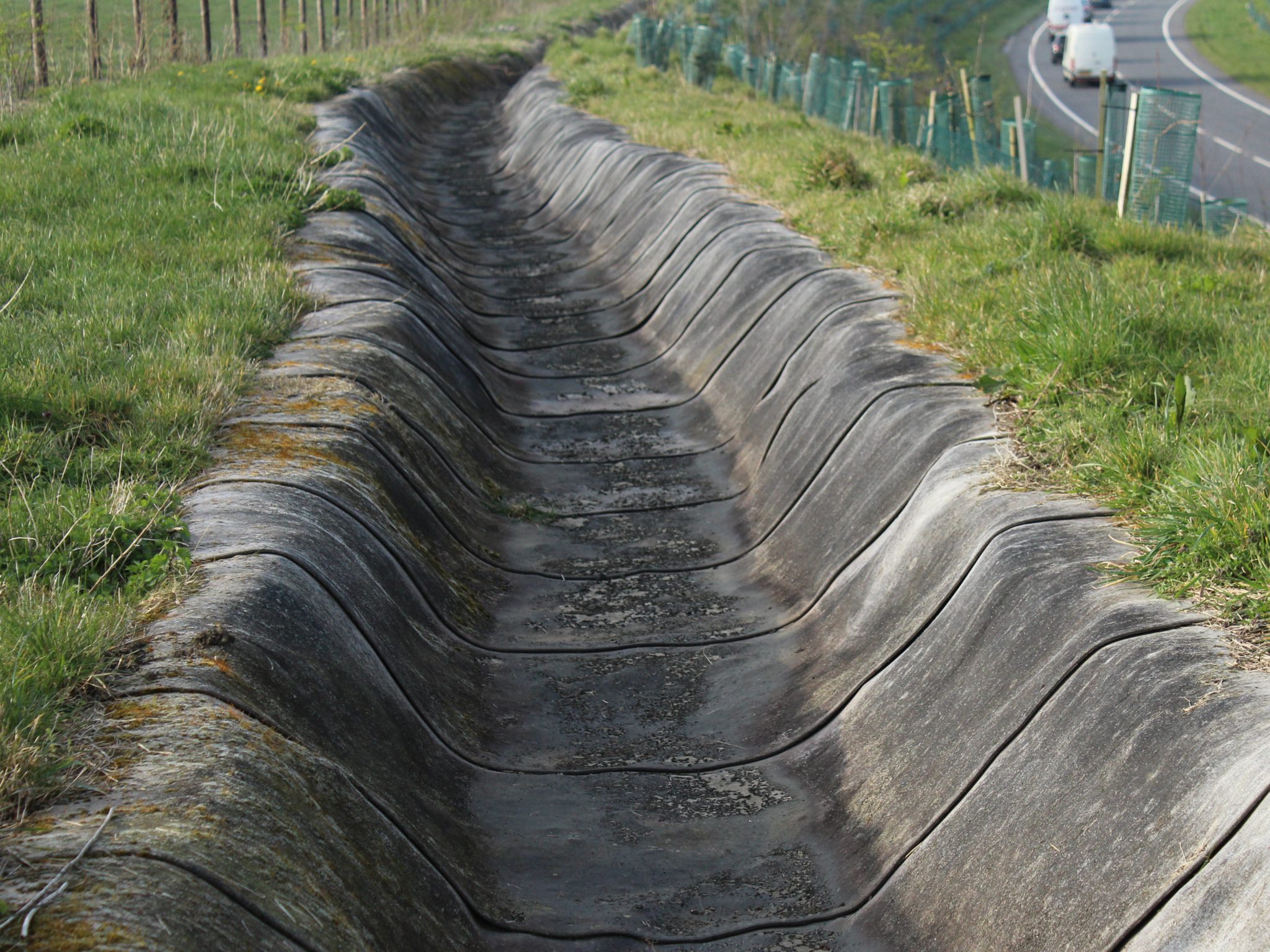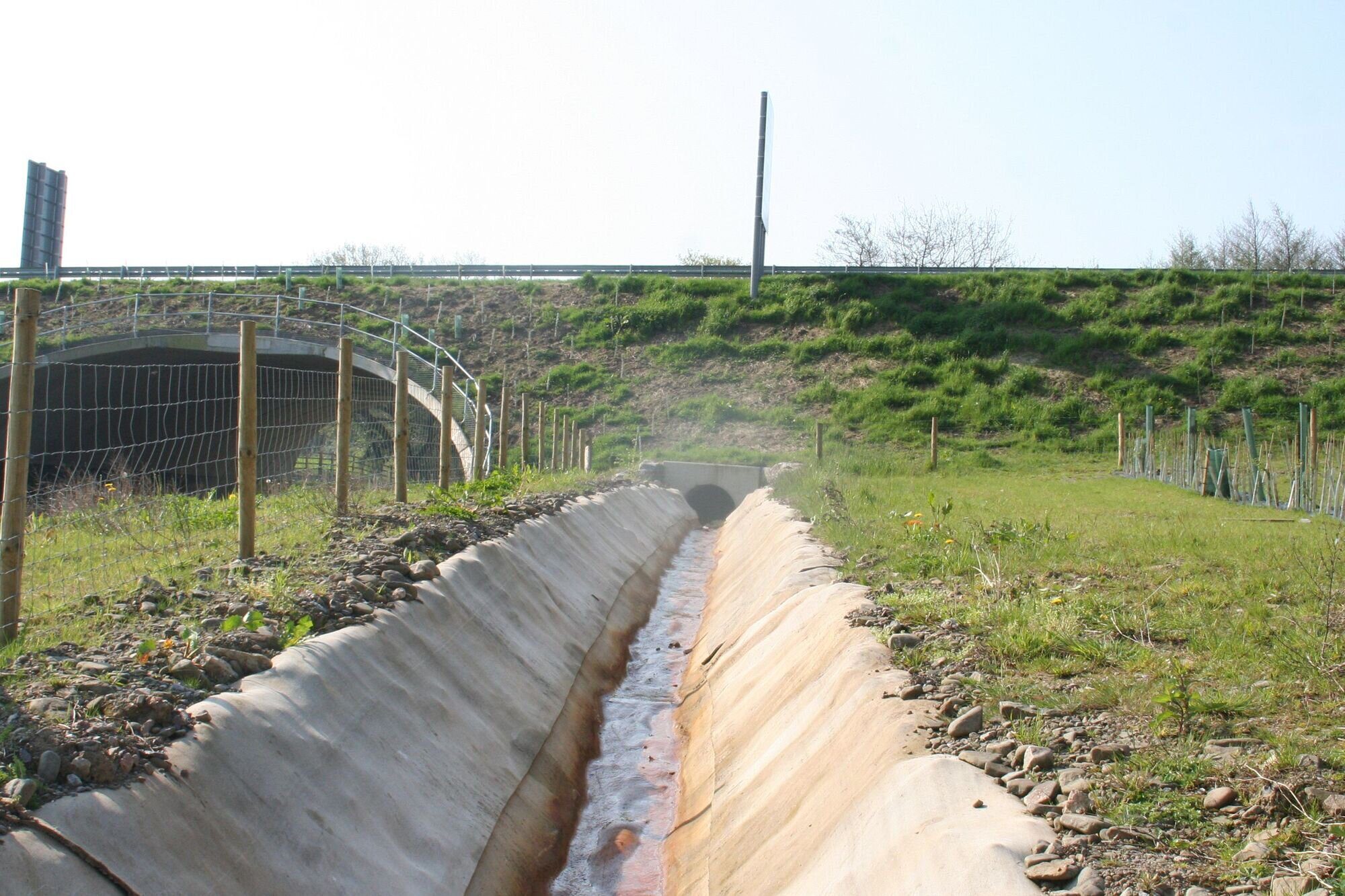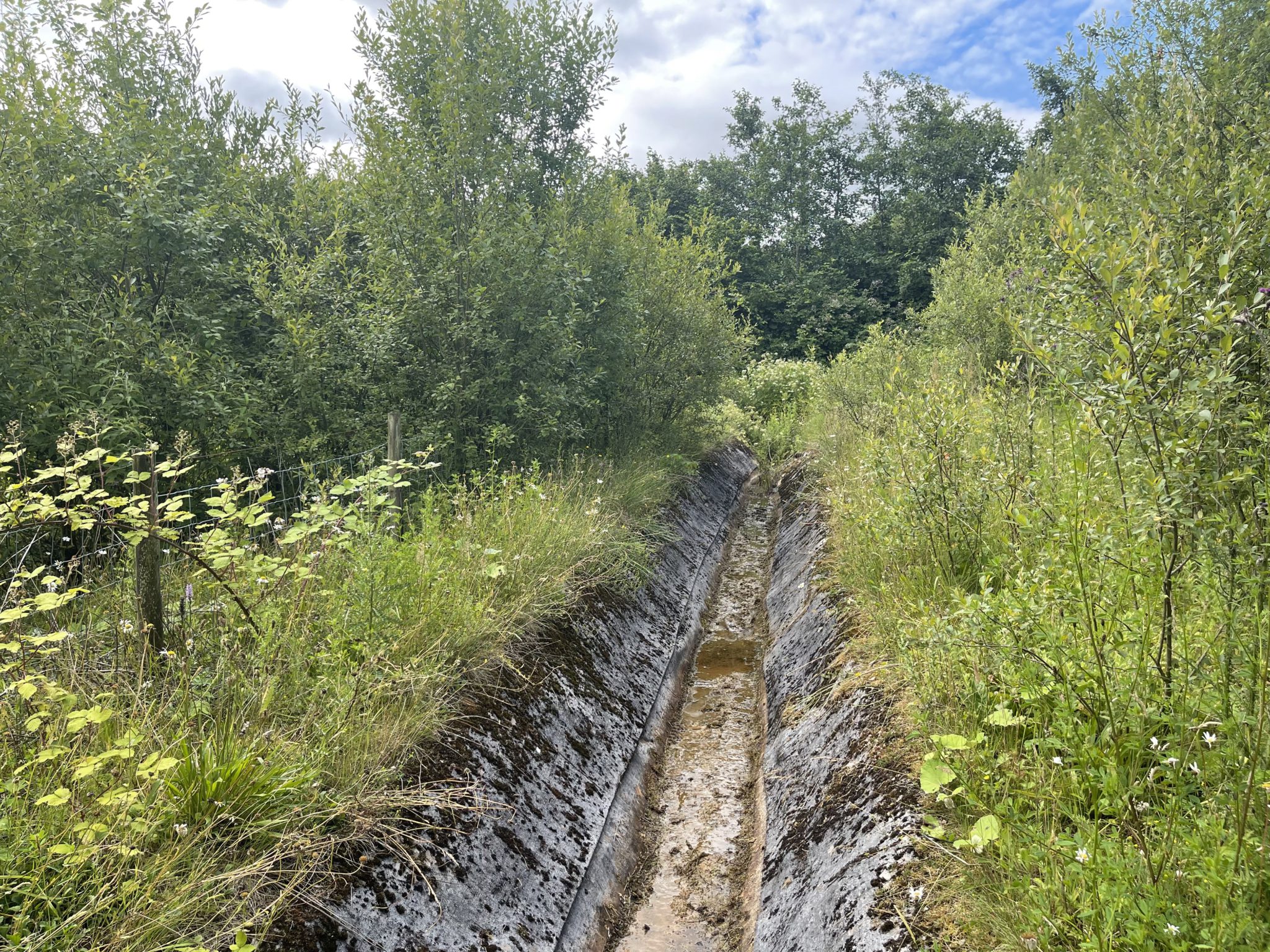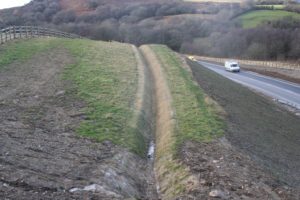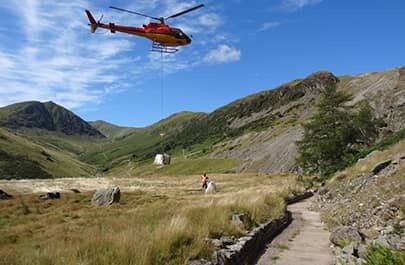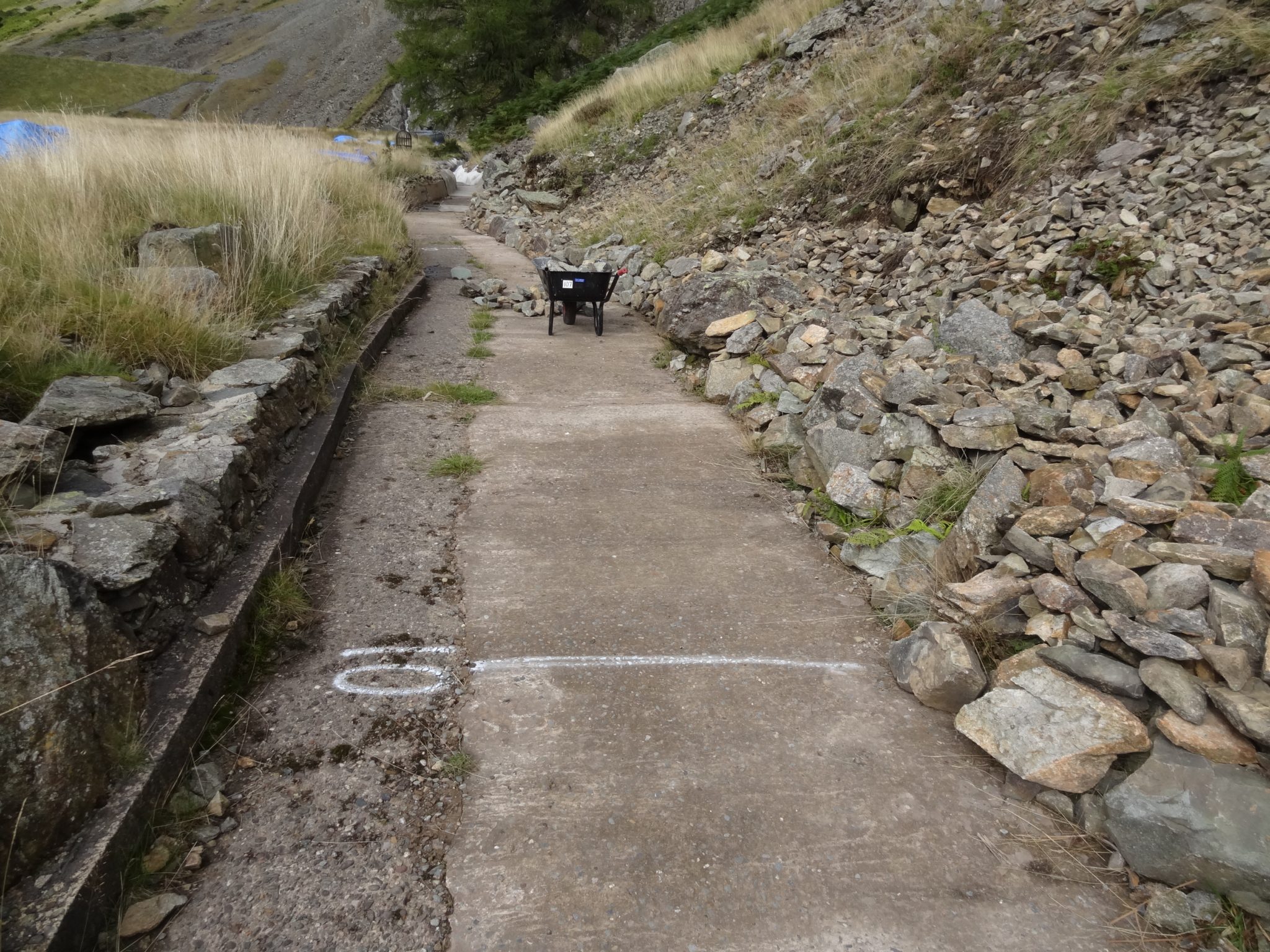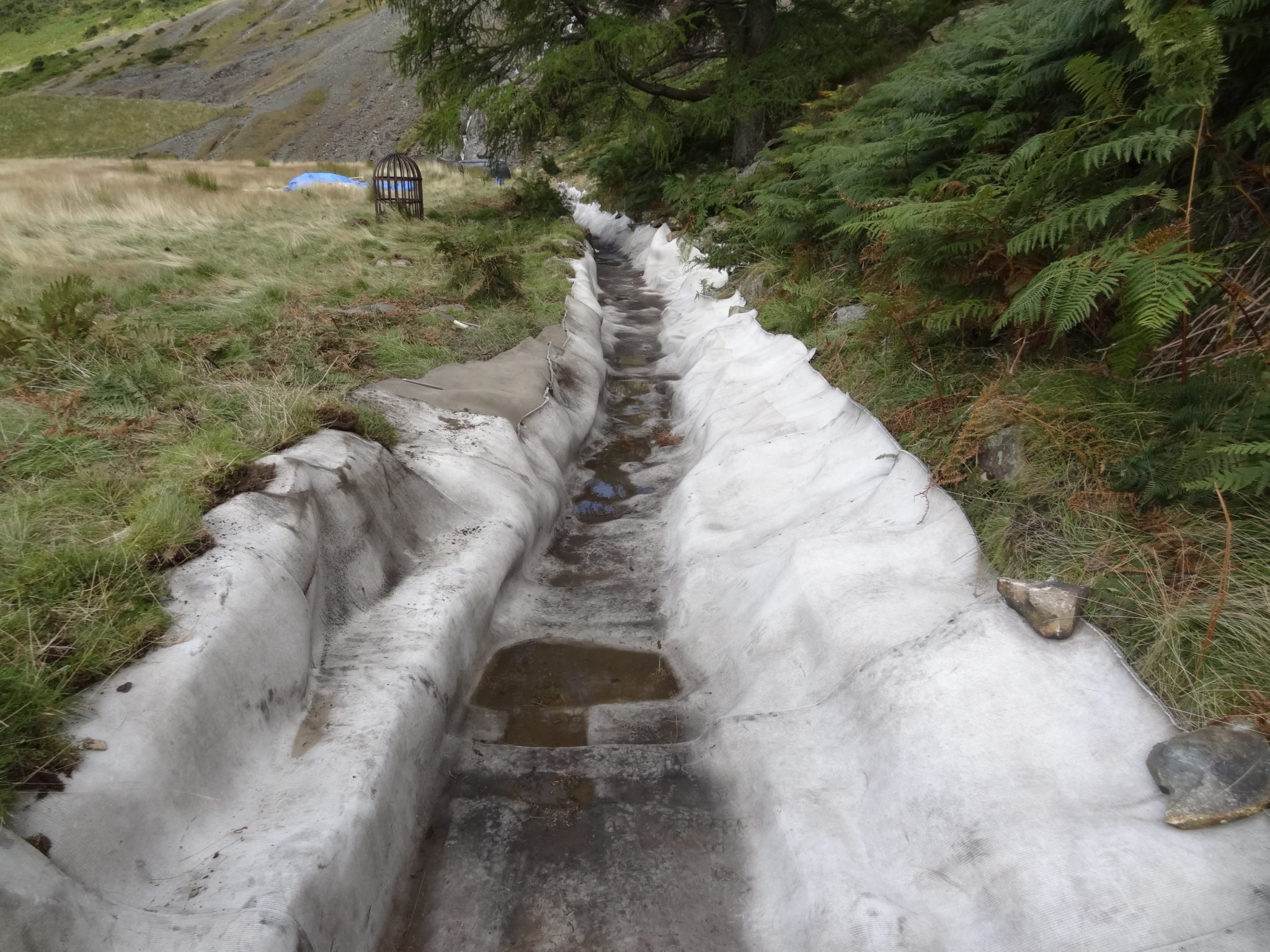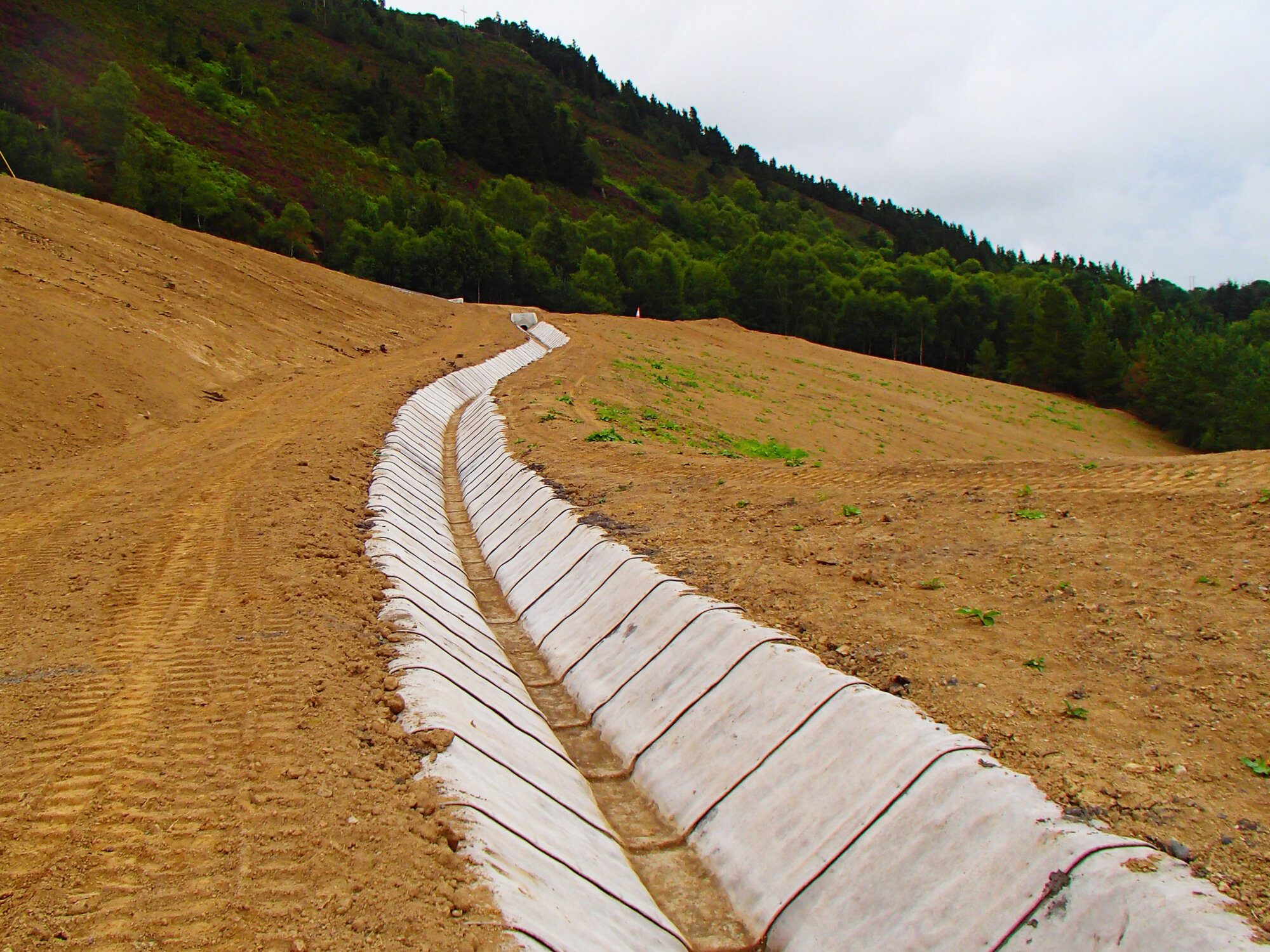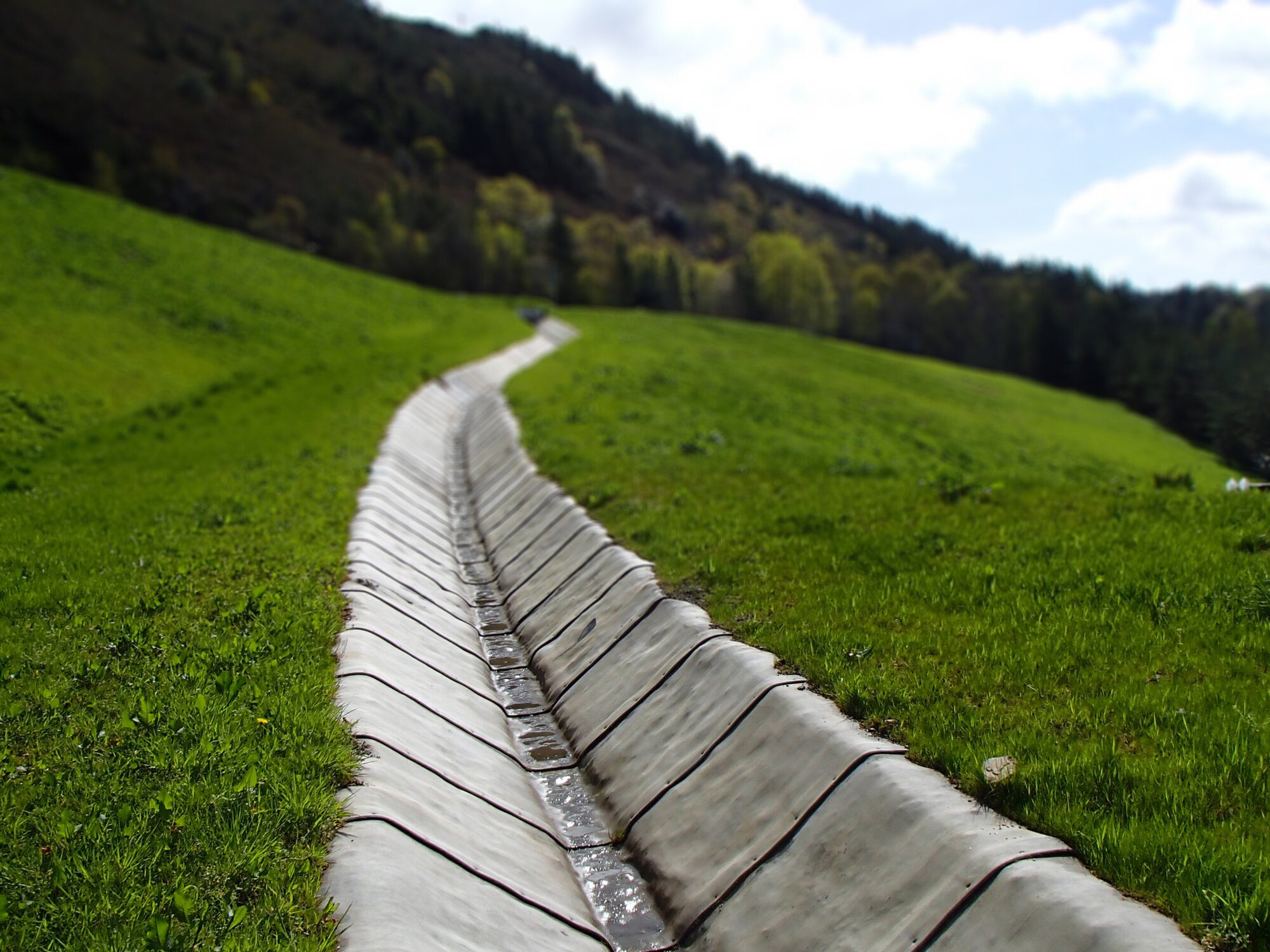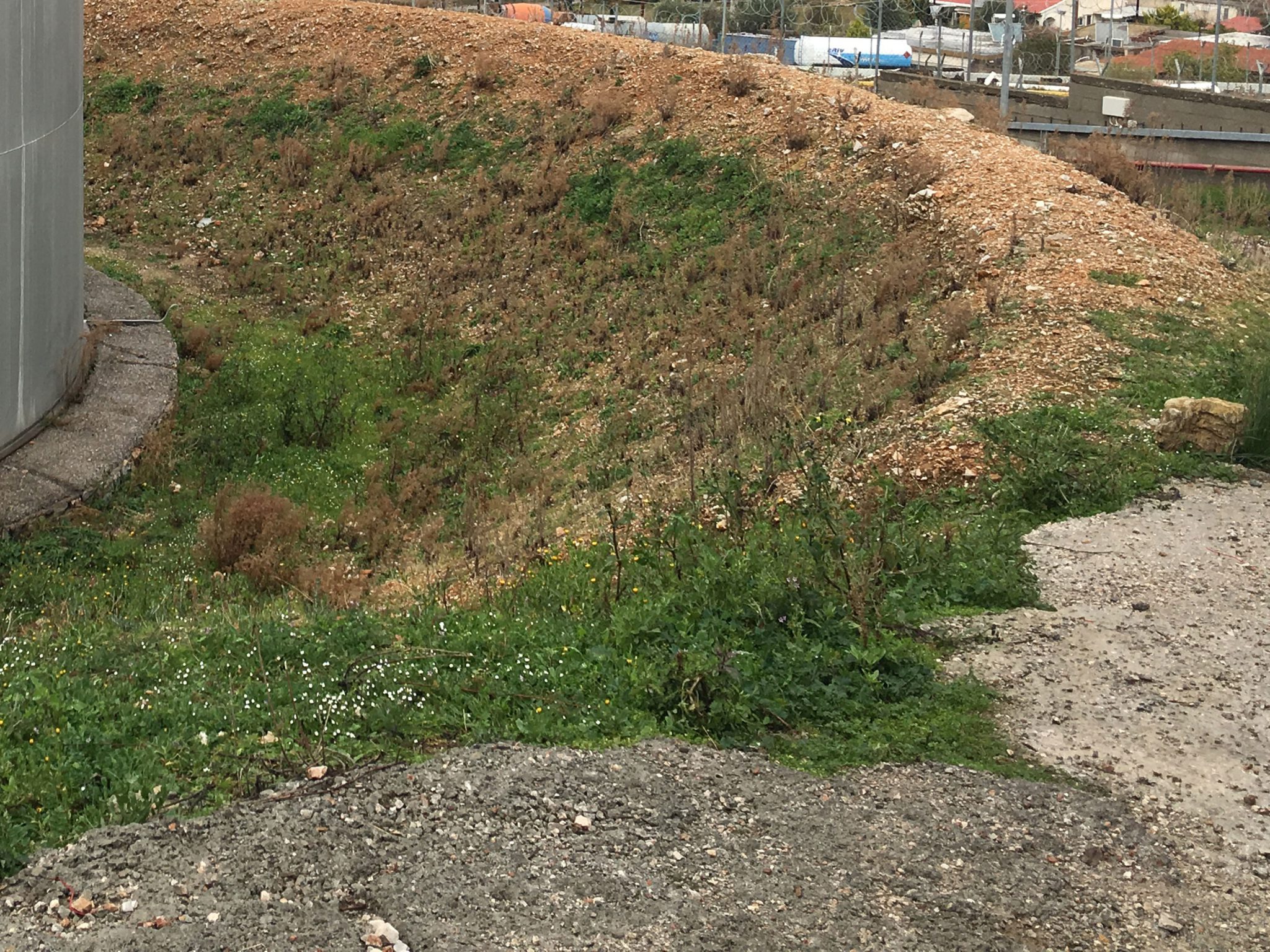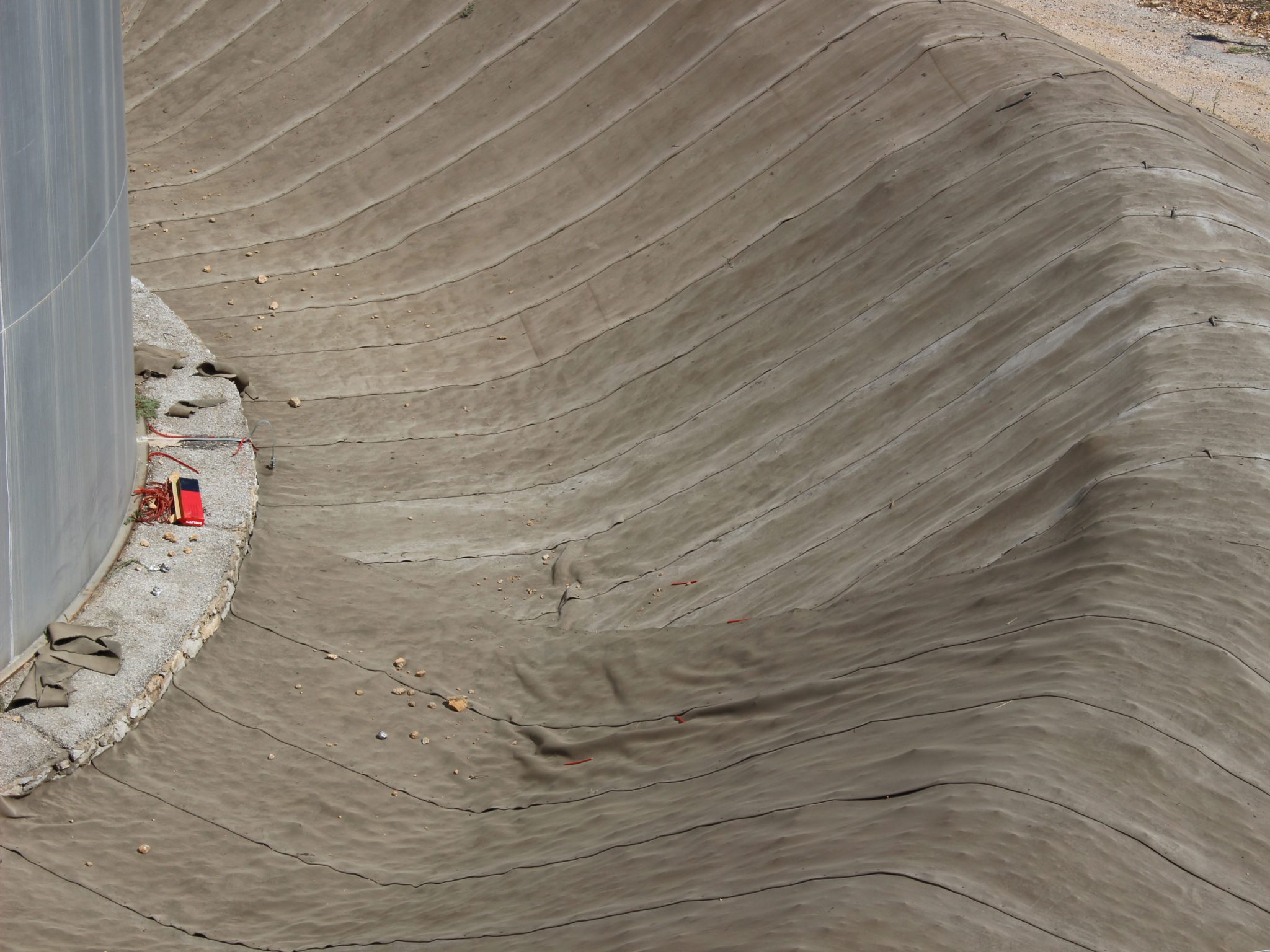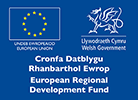Concrete Canvas Channel Lining at Five Mile Lane
In June 2018, Concrete Canvas was specified to provide a channel lining solution to a newly constructed trapezoidal drainage channel that was cut into the eastern crest of the new road cutting. Find out more about the project below.
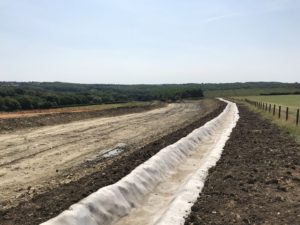
The project
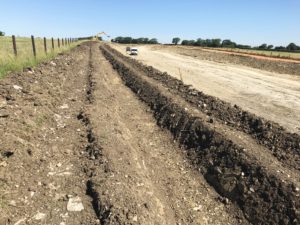
The Five Mile Lane Improvements Project aimed to improve safety along the existing A4226 road (also known as Five Mile Lane) in Barry, South Wales. The scheme involved a combination of improvements including construction of a new road that bypasses the winding central station of the existing road.
The solution
CC was delivered in bulk rolls of the specified 8mm variant (CC8™) and mounted onto a spreader beam for easy deployment. The material was laid transversely across the width of the channel, starting downstream to allow for the creation of material overlaps in the direction of water flow to prevent ingress.
Given the volume and flow rates anticipated, the channel required lining to prevent water ingress into the cutting and scouring of the invert.
The material was cut to length on site to reduce material wastage and accommodate variations in profile width or channel curvature. Each transverse layer was secured within the anchor trench using 250mm ground pegs through the overlapped layers. The material was then also jointed along the overlaps at 150mm intervals using 30mm stainless steel screws, placed 30mm away from the leading edge.
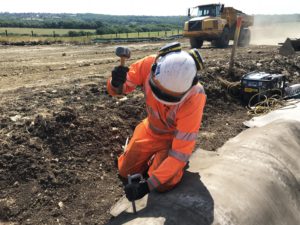
Following jointing and fixing, the CC was hydrated using a 4000-litre bowser and pump. CC reaches 80% strength just 24 hours after hydration, after which time, the anchor trenches were backfilled to bury the material edges, providing a neat termination and preventing any water ingress.
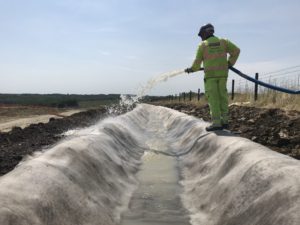
Once set, CC forms a thin, durable, water proof and fibre reinforced concrete layer, providing 7.5x greater abrasion resistance than a poured OPC alternative.
Concrete Canvas® is the original GCCM and the first product to declare conformance to ASTM D8364-Standard Specification. This is the only internationally recognised GCCM specification standard and lists erosion control applications by three classifications, Type I, Type II and Type III. It defines the minimum performance values required for each type based on the use of test methods that are specific to GCCM materials. ASTM D8364 is an important resource for clients, consultants and contractors wishing to ensure the GCCM used on their project is fit for purpose. For Five Mile Lane, we recommended that CC8 which is Type II was used.
The results
Over 2250m² of CC8™ material was installed in less than four days by a crew of 4, using minimal plant. As Concrete Canvas has been approved by BBA to provide durability of 120 years, we expect the relined channel to continue protecting the surrounding environment for many years to come.
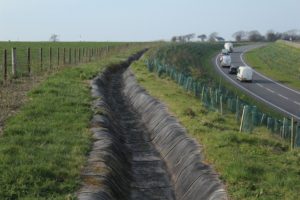
Contact Concrete Canvas for Channel Lining
If you are looking for a flexible and durable concrete solution for your channel lining project, get in touch with Concrete Canvas. We can assess your project requirements to match you with the most suitable type of GCCM. With no need for plant or mixing equipment, we can even guide you through the installation process: simply unroll, secure and add water.
Aged Project
In February 2010, Concrete Canvas was used to line a drainage channel which ran adjacent to a newly constructed bypass. Keep reading to find out why and how Concrete Canvas was used for this project. Below are the comparison images of how Concrete Canvas remains intact and secure to provide a complete channel lining solution within the Church Village area.
The installed channel is still in use to this day. Concrete Canvas has kept the channel weed and erosion free, with water constantly flowing. Ensure that your project’s lifespan lasts by checking for the GCCM Specification Standard ASTM D8364.
Concrete Canvas is the original GCCM and the first product to declare conformance to ASTM D8364-Standard Specification for GCCMs. This is the only internationally recognised GCCM specification standard and lists erosion control applications by three classifications, Type I, Type II and Type III. It defines the minimum performance values required for each type based on the use of test methods that are specific to GCCM materials.
ASTM D8364 is an important resource for clients, consultants and contractors wishing to ensure the GCCM used on their project is fit for purpose. CC8™ is a Type II GCCM as defined in ASTM D8364, it is suitable for use on soil subgrades and was chosen for this project to suit the abrasion, wear and loading requirements. CC8™ is also BBA certified with durability in excess of 120 years when used in erosion control applications.
The project
Set in Church Village, South Wales, a major construction project was underway. In the previous year, Costain had been appointed as the main contractor for a £90m Church Village Bypass Scheme. This involved the construction of two bridge roads, four roundabouts, three community footbridges, two cattle grids and one subway, along with the installation of holding ponds and a surface drainage network.
Costain wanted to use environmentally-friendly materials, such as recycled aggregates, to minimise the impact on the local ecology. Following approval from the Environmental Agency, Costain decided to use Concrete Canvas to line the drainage network.
The solution
At Concrete Canvas, we provide a range of Geosynthetic Cementitious Composite Mats (GCCMs) for channel lining projects. Depending on the project requirements, we can recommend a type of GCCM to suit the needs of the landscape and location. For this particular project, we suggested our CC8™ GCCM be used as an environmentally conscious solution.
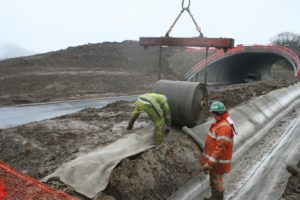
At the site, there was already a drainage channel in place. However, it had become overgrown with vegetation and was no longer suitable for use. Before the installation of CC8™ could begin, the original channel was graded and all vegetation was removed, creating a smooth substrate. With the channel prepared, bulk rolls of CC8™ material were delivered to site and lifted into position using a spreader beam. Using plant equipment made it easier for workers to manoeuvre the bulk rolls, and allowed them to simply pull the material into position.
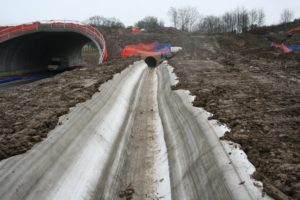
The installation was carried out in three phases, to create longitudinal layers of the CC8™ material. The first phase involved laying the material along the base of the channel and fixing it into the substrate using ground pegs. The second phase involved laying material on either side of the first length, with 100mm overlaps. These overlaps could then be jointed using screws at 200mm intervals. It was decided that the overlaps would not be fully sealed, allowing natural weep paths to form. The third phase involved creating anchor trenches on each shoulder of the channel for the CC8™ material to be fixed, which were later backfilled following hydration.
The results
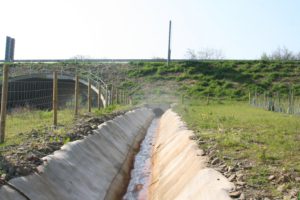
A total of 240m² of CC8™ was installed to complete the drainage network as part of the Church Village Bypass Scheme. By using Concrete Canvas, Costain were able to complete the scheme in a time-efficient and cost-effective manner, whilst having a minimal impact on the surrounding environment. After the completion of the project, we received the following feedback from Daniel Powrie, the Project Manager at Costain.
“The Church Village Bypass scheme presented our team with a unique challenge. The location and nature of the works required the sensitive use of appropriate construction materials in order to minimise the impact on the local environment. Concrete Canvas provided a means of rapidly installing a low carbon concrete ditch whilst maintaining the natural aesthetic of the overall scheme.” – Daniel Powrie, Project Manager, Costain Group.
Contact Concrete Canvas for Channel Lining
If you are looking for an environmentally-friendly solution for a channel lining project, get in touch with Concrete Canvas. We can assess your project requirements to match you with the most suitable type of GCCM. We can even guide you through the installation process: simply unroll, secure and add water.
Concrete Canvas Channel Lining at Greenside Mine
In 2016, Concrete Canvas was used to reline an existing channel on top of a tailings dam, preventing severe flooding and storm damage. Find out more about the project below.
The location
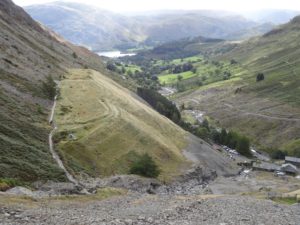
Greenside Mine was once the UK’s largest producer of lead ore, having been in continuous operation for over 150 years. Whilst it had been closed since 1961, there was still significant evidence of the mining techniques that were used at the site, leading to it being designated a Scheduled Monument. Having been out of use for more than 60 years, the site had also grown into a natural scree habitat, with species such as Juniper and Parsley Fern making it a Site of Special Scientific Interest (SSSI).
This was an extremely sensitive location, which required collaboration between the Lake District National Park Authority, Coal Authority, Environment Agency and the 7-5 Engineer Regiment under 4-2 Brigade to ensure the area remained protected throughout the duration of the project.
The project
As a past mining location, the site had a tailings dam which had been used to store excess material. Above the tailings dam, there was a 200m long channel, which had been causing runoff damage during periods of heavy rainfall. To protect the environment, it was decided that this channel needed to be relined with a durable solution.
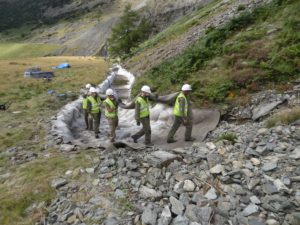
Previously, the Lake District National Park Authority had used dry stone walling and poured concrete to reline the channel. However, both of these techniques posed logistical issues due to the rural location of the site and proved ineffective at preventing runoff damage. Instead, the Coal Authority, who provide geotechnical advice to the Lake District National Park Authority, recommended the use of Concrete Canvas.
The solution
Concrete Canvas® is the original GCCM and the first product to declare conformance to ASTM D8364-Standard Specification. This is the only internationally recognised GCCM specification standard and lists erosion control applications by three classifications, Type I, Type II and Type III. It defines the minimum performance values required for each type based on the use of test methods that are specific to GCCM materials. ASTM D8364 is an important resource for clients, consultants and contractors wishing to ensure the GCCM used on their project is fit for purpose. For Greenside Mine, we recommended that both CC8 which is Type II and CC13 which is Type III were used.
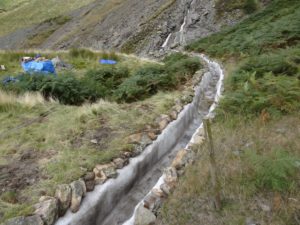
The Greenside Mine site was located on a steep hillside, two miles up a remote track. This presented initial logistical issues, with no way of off-loading the materials on site. Instead, the material was by HIAB wagon to a location that was 500m away. From here, the materials were flown into position by commercial helicopter, avoiding the impact that wheeled vehicles or tracked machinery would have had on the environment.
To accommodate for the varying profiles of the channel, it was made sure that all rolls of CC8™ were batched to specific lengths. These rolls were then labelled and palletised into loads that weighed less than 950kg, allowing them to be subsequently lifted and accurately positioned by helicopter. Once the rolls were in place, they were trimmed and anchored to the ground using steel pegs and heavy rocks, with any overlaps being jointed using stainless steel screws at 20cm centres. An army-issue 10,000 litre reservoir was then used to hydrate the rolls and set them in place.
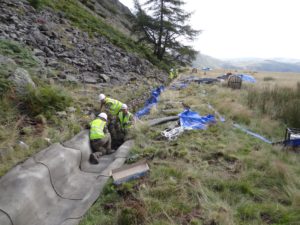
The results
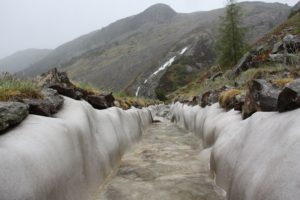
In total, 837m² of CC8™ and 128m² of CC13™ were used to reline the channel at Greenside Mine. Since the installation, the channel has effectively prevented runoff damage to mining material. As Concrete Canvas has been approved by BBA to provide durability of 120 years, we expect the relined channel to continue protecting the surrounding environment for many years to come.
“The Concrete Canvas is still working as effectively as when it was installed. We’ve had about half a dozen really heavy rainfall events since it went in and on every occasion the runoff from the hillside above the tailings dam has been intercepted and safely conveyed directly into the beck without causing any erosion of mine material. At the end of October 2021 the site received 400mm of rainfall in six days, the wettest week since Storm Desmond in December 2015. The Concrete Canvas performed exactly as it needed to and there was no erosion of any mine material.”
Martin Lord – Project Manager, Lake District National Park Authority
Contact Concrete Canvas for Channel Lining
If you are looking for a flexible and durable concrete solution for your channel lining project, get in touch with Concrete Canvas. We can assess your project requirements to match you with the most suitable type of GCCM. With no need for plant or mixing equipment, we can even guide you through the installation process: simply unroll, secure and add water.
Concrete Canvas Channel Lining at Avoca Mines
In 2017, Concrete Canvas was used to provide scour protection to drainage channels at the Avoca Mines in Wicklow. Find out how the project went below.
The location
Copper mining is reported to have begun in the Avoca River valley in 1720 and continued, intermittently, until 1982. Consistent mineral extraction has left an environmental legacy that comprises of open pits, shafts, spoil piles and former mining buildings.
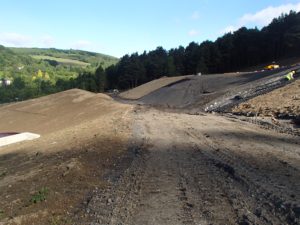
The project
During health and safety works that were being carried out by Civil and Environmental Engineering Contractor, Priority Construction Ltd., it was identified that the former mining site was impacting the quality of the water in the Avoca River. Water dischargers from abandoned copper and sulphur mines were acidic and metal laden, contaminating the nearby river water.
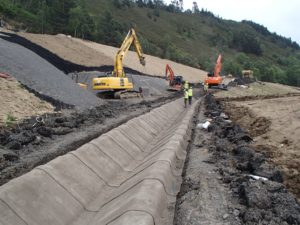
It was decided that the spoil areas would need to regraded and capped, with drainage channels to redirect upstream drainage around the site, instead of through it. Whilst the original design used a combination of precast concrete channels and HDPE liner, there were concerns around the long lead in times for the precast concrete and the construction risks associated with steep slopes. Instead, Priority Construction Ltd. proposed the use of Concrete Canvas.
The solution
At Concrete Canvas, we offer Geosynthetic Cementitious Composite Mats (GCCMs), which are an alternative to traditional concrete methods. Unlike most concretes, our GCCM uses a specialist high early strength concrete, with a limited alkaline reserve. This means it has a very low wash out rate and can be directly discharged into the water course, without the need for prior treatment, making it an ideal solution for channel lining.
For this project, we recommended the use of CC13™, which is our thickest type of GCCM. However, before the installation process could begin, the channel needed to be excavated and compacted to profile. A 250mm x 250mm anchor trench was then built on either side of the channel to allow the leading edge of the GCCM to be buried, preventing any undermining. Once the channel was prepared, the CC13™ was mounted onto a spreader beam and hung from an excavator, allowing it to be easily unrolled. Each piece of CC13™ was cut to a specific profile length and dragged into place, minimising material waste.
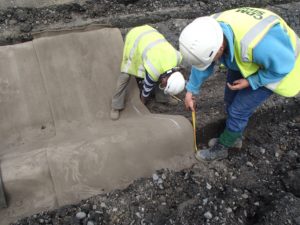
Priority Construction Ltd. installed the CC13™ transversely to accommodate for change in the channel profile, with layers overlapping by 100m in the direction of the water flow. The overlaps were then sealed using Everbuild Clearfix adhesive sealant and screwed together using stainless steel screws. As an extra precaution against undermining, 250mm steel ground pegs were also inserted into each overlap in the anchor trenches and then backfilled with material.
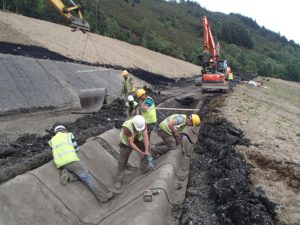
As the channel was located on a steep hill, concrete steps were installed to dissipate the water energy. Due to the flexibility of CC13™, it was able to be laid over each step and pinned into the vertical interface of the steps using Hilti anchors. After each day of work, the CC material was hydrated using a hose and a 6000ltr water carrier.
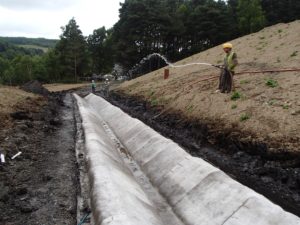
The results
In total, 1,520m² of CC13™ was installed within two weeks, providing long-term scour protection and erosion control for the network of drainage channels on the site. Despite the steep and varying slopes, we achieved installation rates of over 200m² per day.
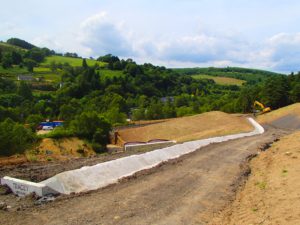
Following the success of this installation, Concrete Canvas is now being considered for multiple projects in the same region, in both the public and private sectors.
“After carrying out some research into alternatives for in-situ or precast concrete drainage channel we encountered Concrete Canvas. As we learned more about this solution we realised it would be ideal for the Avoca Mines Remediation Project which we had been awarded. We succeeded in gaining approval from the client for the use of Concrete Canvas. As the project progressed it became clear that this solution provided a number of benefits when compared with traditional methods. These benefits included speed of installation and flexibility in terms of levels e.g. where there were changes in design levels. I intend to use this product on future projects where possible.”
Ken Madden – Senior Contracts Manager, Priority Construction Ltd.
Contact Concrete Canvas for Channel Lining
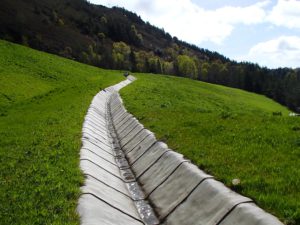
If you are looking for a flexible and durable concrete solution for your channel lining project, get in touch with Concrete Canvas. We can assess your project requirements to match you with the most suitable type of GCCM. With no need for plant or mixing equipment, we can even guide you through the installation process: simply unroll, secure and add water.
Concrete Canvas Bund Lining in Greece
In 2017, Concrete Canvas was used to line a bund at a petroleum tank farm, which required weathering protection and weed suppression. Keep reading to find out more about the project requirements and how Concrete Canvas met them.
The project
Located in Athens, Greece, was a petroleum tank farm that required bund lining. The existing bunds were heavily vegetated, which was putting the site at risk of fire during the extremely hot summer months, with temperatures often hitting highs of 48 degrees Celsius. The bunds were also subject to weathering and erosion, which was impacting the integrity of the ground below the tanks. It was decided that the farm required a hard-wearing and cost-effective solution, with weed suppression characteristics, to restore its stability and safety.
Initially, traditional concrete combined with Shotcrete was considered for this project. However, there was a risk of rebound from Shotcrete, which would affect the site environment and infrastructure. There was also an issue with site access, which would make it difficult to use the heavy plant machinery that’s required for traditional concrete methods. As a result, Concrete Canvas was specified for the project.
The solution
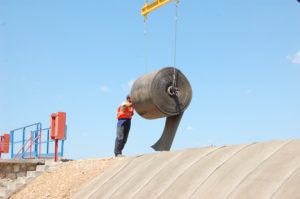
At Concrete Canvas, we offer Geosynthetic Cementitious Composite Mats (GCCMs) for effective bund lining. Providing weed suppression and erosion control, our GCCMs have been used for multiple bund lining projects in the past, proving to be suitable for a variety of petrochemical, oil and gas sites. For the project at the petroleum tank farm, we recommended the use of our CC5 GCCM.
Before we could begin the installation process, all vegetation was removed, along with rocks and debris from the area. Once the ground had been re-levelled, the contractor was able to manoeuvre our CC5™ rolls into position on the crest of the bund slope. The CC5™ was then unrolled down the slope and across the tank floor, with the guidance of two members of the installation team.
At the top of the slope, we had a concrete slab poured, which is where the CC5™ rolls were secured using masonry nails. This process was then repeated along the length of the slope, with additional layers overlapping by 100m. For each overlapping layer, Everbuild Clearfix adhesive sealant and Hilti collated screws were used to secure the rolls to the surface.
As the CC5™ material is so flexible, it could easily accommodate the petroleum storage tanks and pipework during the installation process. Around any walls, corners and protruding infrastructure, we cut the CC5™ material by hand, with extra layers being fitted around items where needed.
To complete the installation of the CC5™ GCCM, the material was hydrated using hoses attached to fire pipes. This was repeated three times to ensure adequate hydration in the high temperatures of Athens, Greece.
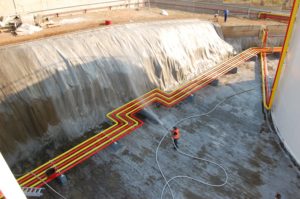
The results
6,400m² of CC5™ was installed over nine days in consistently high temperatures. Once the bund lining installation was complete, the client expressed how impressed they were with the immediate effectiveness of the product. The client and contractor also commented on the cost efficiency of our GCCMs, compared to traditional concrete methods.
With Concrete Canvas proving to be an effective solution for bund lining at their petroleum tank farm, the client is now interested in exploring the suitability of our GCCMs at more of their tank farms in Greece.
Contact Concrete Canvas for Bund Lining
If you are looking for a hard-wearing and cost-effective solution for your bund lining project, get in touch with Concrete Canvas. We can assess your project requirements to match you with the most suitable type of GCCM. With no need for plant or mixing equipment, we can even guide you through the installation process: simply unroll, secure and add water.
